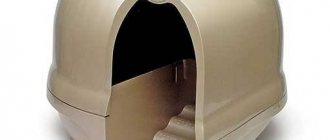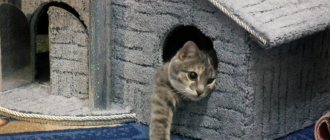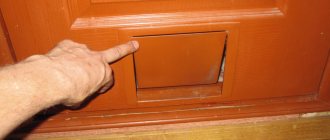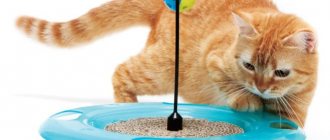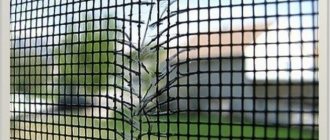Everyone loves cats when they snuggle up on the couch, snuggle up, or purr on their laps. But no one likes cleaning cat hair from clothes and repainting torn joints. Today we decided to tackle one specific problem - the tray that constantly catches our eye. The master class will be especially useful for those who, due to the layout of the house, are forced to place the cat litter in a prominent place.
You will need:
- Plywood with a thickness of 12 to 15 mm for the walls of the house.
- 4 cm wide boards for the roof (about a meter in total).
- Nails and hammer, screws and screwdriver.
- Wood glue (PVA).
- Jigsaw.
- Miter saw (or hacksaw).
- Drill.
- Roulette.
- Two small furniture hinges.
- for the door.
- Sandpaper.
- Tracing paper.
- Masking tape.
- Dye.
Main types of toilets
a variety of cat litter trays on their shelves Some of them involve the use of filler, others have a plug-in grille for liquid drainage. Often, products for pet hygiene procedures are divided into two large groups: open and closed toilets. Depth, size and shape can also be criteria for distinguishing them. In order to make the right purchase of a cat litter box, it is necessary to study the nuances of using different types of this product.
Ordinary plastic one-piece tray
A fairly common and popular model is a one-piece plastic tray . It is a rectangular product with low sides. Often no additional accessories are included with it. The main advantages of this type include low cost and compactness. It is also easy to maintain. If a kitten chooses a toilet, then this is an excellent model: it’s not at all difficult for a baby to climb into a tray of this type.
If the toilet is chosen for an adult cat, then this is by no means the best option: the shallow depth causes constant chaos in the place where the toilet is located. To prevent the litter from being thrown out when buried, it is better for adult pets to choose one of the following types, such as a litter box for cats with a mesh, a tray with high sides, or a closed model. Also, the disadvantages include the possibility of using this option only with filler.
Tray with high sides
A tray with high sides is similar to a regular one-piece plastic model, but is equipped with removable sides. This additional parameter can be used to fix the film, which can be easily removed after the pet has relieved itself. This makes the product easier to maintain: there is no need to wash anything.
Another advantage of this model is its depth: thanks to the ability to raise the sides to the required level, the cat will not scatter the litter beyond the boundaries of its litter box. This type makes it possible to use both filler and film. But there is also a disadvantage when using this version of the tray: it is much larger than the product described above, so it requires more space.
Tray with mesh
The next type of cat litter with a mesh is also similar to an ordinary plastic model, only a mesh is placed on top of the product. Thanks to the use of this accessory, all excrement passes through the grate into the tray, and the pet’s paws remain clean and dry.
No filler is required to use this option. But this is the reason for the disadvantage of this model, which is the impossibility of neutralizing the smell and its further spread throughout the apartment. Therefore, after each management of the pet, it is necessary to clean it. In addition, it is worth adding that not all cats like this type of toilet. This is due to the situation when a cat’s claws get caught in the bars when the burrowing instinct manifests itself, and she herself gets scared.
Tray house for cats
Many owners prefer a closed cat litter box or, in other words, a litter box. This product is comfortable to use for both the owner and the animal. Some models even have doors that prevent odors from spreading from the tray. But not every cat likes such an accessory.
It is worth noting that a closed toilet has a number of advantages over other toilet options:
- the product perfectly retains the “aromas” inside it;
- many pets love an enclosed space that gives them a sense of security;
- the filler does not end up outside the boundaries of the tray when buried;
- the cat does not accidentally walk past the toilet, unlike open litter boxes.
The disadvantage of this type relates not to operation, but to cost. Due to the high price, not every owner can purchase a toilet house for a cat.
Automatic tray
, automated closed toilets for cats are on sale . They represent a real advancement in the cat litter industry. The products fit aesthetically into the bathroom of the house. And they don’t require much effort to keep the pot clean. Naturally, the cost of a self-cleaning cat litter box is quite high. But if there are a large number of animals in the house and there is no time to clean up after them, this model becomes the best option. The disadvantages of the automated option include the loud sound produced by the product during the cleaning period.
Recommendations for use
Your pet sees a closed cat litter box for the first time, and you are faced with the problem of training. There are several tips to simplify and speed up the process:
If your pet accepts the improved litter box favorably, consider yourself lucky. Now you will appreciate the ease of cleaning, the level of cleanliness in the apartment and create comfort for your beloved pet. Perhaps at first buying a closed litter box may seem like a waste of money, but in fact it is a great thing for any cat owner.
From a plastic container
The easiest and cheapest way to hide a tray. Unlike the previous ones, which are designed to hide cat litter in a hallway or room, this one is perfect for a bathroom or restroom, where the requirements for appearance are softer and the size of the structure is stricter.
Cat litter is unsightly and sometimes smelly, it's generally a nuisance, but if you have a cat, you have to have cat litter. Every cat owner wonders where the best place to place the cat litter box is. And yet, when the tray catches your eye, it involuntarily causes a grimace. It's time to fix it! Look at these unusual ideas for hiding cat litter and smile, and maybe some will even be useful.
Cat litter on the bench
Such a bench, purchased at a hardware store, furniture store or online store, has space that can be used for a cat litter box. There is also a separate compartment for filler. It has holes in the sides to ensure sufficient ventilation. One door can be closed to hide the filling compartment from view.
Hide cat litter in the cabinet
Living in a small apartment has several challenges, including the problem of placing a toilet for your furry pet. Is there a place for it and extra space to hide a less-than-aesthetic item? Make your own cabinet where you can place it. When the doors are closed, no one can even guess what is hidden there.
Curtains will hide the excess
This idea can be a beautiful way to hide your cat's litter box. Bright fabric will enliven a small table and become a comfortable place for your pet. You can use Velcro strips to open the curtain to make it easier for your cat to get in. However, it's easy enough to lower down and your guests will be sure that you just updated a boring piece of furniture.
Wooden house
To make such a box for a cat, you don't need any special skills. Simply join two wooden boxes together and cut an opening large enough for your kitten to enter comfortably. If you secure it with hinges, the design will be more convenient.
Fans will definitely love this item! The cat litter was perfectly camouflaged under a flower pot. It can be painted in the color that will match your interior.
Old wardrobe
Don't rush to throw away your old small cabinet. Simply refresh the paint and place everything you need for your pet. There is enough space for a tray, and filler, food, bowls and various small items will be hidden on the shelf.
Closet cutout
Do you want to install a cat litter box in a small bathroom? Cut a hole in the cabinet under the sink and place a box inside. Then the toilet will not get in the way and will be easy for both your cat and you to get to in order to clean it up. Such a curly neckline will be especially interesting.
Source
What to consider when choosing
Making a toilet for a cat with your own hands or buying one is the first thing owners of four-legged creatures think about. You need to give preference to a specimen that your pet will like and that you find convenient in terms of cleaning (do not forget that you will have to clean the tray quite often). To ensure that you are satisfied with your purchase, consider the following recommendations:
- buy the tray at an average price. A copy that is too cheap may not last a couple of years for your pet, but an overly expensive one is already an unnecessary luxury. Take into account the fact that the toilet must be used by the cat throughout its entire life - in adulthood, it is even more difficult to accustom a four-legged pet to changing the tray than a kitten;
- availability of space. Choose a litter box for your cat that is large enough for him to fit in completely. Some cat owners prefer to buy a mini-house for their tailed baby, but then it turns out that he grew up too quickly, and the money, in fact, was wasted. That is why, when deciding on the size of the tray, choose according to this principle so that an adult cat fits there;
- durable but fairly lightweight material. It is best to give preference to plastic;
- The surface of the tray should be smooth. If there are any decorations or roughness or defects on it, your four-legged pet may one day be seriously injured;
- An indoor dry toilet is not always suitable for cats. Pay attention to your pet's habits. If he doesn't like being left alone for long periods of time, he might not be too impressed with a toilet with a roof;
- easy to clean. It is very important that you can clean the cat litter without unnecessary complications;
- not too bright color and no strong smell. If the shade of the material is not flashy, and the tray does not give off the characteristic aroma of paint and other nonsense, you can safely buy such a litter box for your cat.
You need to be careful when choosing a toilet for your kitten. Stick to the basics and buy one that your four-legged friend will get used to quickly.
Moral preparation of the animal
Unless Kuklachov can find a common language with a cat instantly, and she will fulfill his every desire. Ordinary people will have to think about how to train a cat to use the toilet. Of course, each animal is unique, but there are a number of steps that can be formulated that will help in most cases.
Instructions for taming a cat to a plumbing fixture look like this:
- First, the cat needs to get used to the idea that the toilet will now be located at some height above the floor. It is recommended to raise the tray on the floor a little every day so that its height eventually becomes equal to the height of the toilet;
Every day the height increases
- then the cat litter is installed on the toilet. To begin with, you can lift the lid and simply cover the free space with cardboard or other durable material, secure it with tape and pour in a little filler. The cat will be suspicious of the toilet, but the usual litter will calm it down;
To keep the animal calm, you can add a little filler.
- then you can try to make a hole and constantly enlarge it. Over time, the animal will get used to standing on the very edge. Although you can continue to use the toilet tray, it will simply be more comfortable for the animal.
Note! It is not recommended to teach your animal to wash off after itself. Some cats perceive this as a game and may flush the water over and over again. The price of such entertainment will be noticeable when paying for water supply.
Some cats are intrigued by the drain of water.
If a suitable tray for a plumbing fixture is not commercially available, then it can be made from scrap materials, for example, from a lid for a plastic bucket. At first, such a lid is simply put on the toilet, then, as the animal gets used to it, the hole in the central part gradually increases each time.
The hole keeps getting bigger
The duration of addiction depends on the individual characteristics of a particular animal. On average it will take 3-4 weeks.
Taming Guide in Pictures
Analogue of a regular toilet of a smaller size
As a rule, they are equipped with motion sensors to avoid problems with flushing. Requires connection to sewerage, water supply and electricity to operate.
The motion sensors are configured in such a way that when a cat is in the toilet for 5-10 seconds, it drains within 4 seconds, which is enough to neutralize liquid waste. If the cat stays in the toilet for more than 10 seconds, it will most likely be necessary to flush the solid waste, which will take 6 seconds. Flushing does not occur immediately after this time ends. The process starts 15 seconds after the animal moves away from the sensors. This is set up so as not to cause fear in the pet.
This toilet does not require special filler or detergents, which means that its operation will be somewhat cheaper.
Criteria for selecting a closed tray
The design of the toilet must be strong and heavy, otherwise the entire contents along with the tray may tip over when the pet moves awkwardly. Pay attention to the height of the sides - the filler should not spill out when closing the top of the tray. The overall height inside the tray should be suitable for the pet's height. Cats do not like cramped spaces, but for small kittens, high sides can be a serious obstacle. So make your choice according to the size of your cat. A large indoor toilet is suitable for large purebred cats, while for medium-sized pets it is reasonable to choose a smaller device. Consider a toilet with filtration or vents. The animal may avoid enclosed spaces with the pungent odors of previous feces, so they must be well absorbed or ventilated - this depends on the design of the tray.
